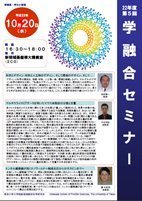AY2010 5th Gakuyugo Seminar
- Date&Time:
- Oct 20, 2010 16:30~18:00
- Venue:
- Large Lecture Room (2C0), New Frontier Science Bldg.

Science and design: the design of materials and artifacts, and the design of environments and ...
Professor Shuichi Iwata
We will analyze the current state of design science in each of the following areas, and consider the relationship between design and science: materials, artifacts in general, and the environment. Historically, we have been able to create things without relying on science. Historically, things have been created without relying on science, and interesting things have been created by imitation without thinking about creativity. There was no need to make a big deal about ethics, morality, mission, etc. There was no problem in the big picture. The invisible hand adjusted the whole thing just right. How long can such good fortune last?

Classification and quantification of mouse body fat using multi-slice CT data
Associate Professor Akihiro Nakaya
Many traits related to humans and other organisms are observed as "quantities. These include height and weight, blood pressure, blood glucose, and body fat, which are related to the so-called metabolic syndrome, as well as traits related to health and medicine, such as symptoms associated with mental illness. The growth and yield of crops and livestock, as well as their resistance to disease, are also quantities that are closely related to food and energy issues. Such traits that are observed as a continuous distribution of quantities with defined size relationships are called quantitative traits (QT), and are treated separately from discrete qualitative traits with no defined size relationships, such as whether a flower is red or white. As emphasized by the concepts of "complex trait" and "polygenic trait", multiple genetic factors are thought to be involved behind quantitative traits. On the other hand, regardless of the presence or absence of such a complex genetic background, there are many traits for which the data itself has become "complex" in terms of both semantics and data volume due to recent advances in observation devices. (For example, traits related to the three-dimensional structure and spatial arrangement of organs in the mouse that are observed in X-ray computed tomography (CT) data. These traits are given in the form of color values and X-ray absorbance information of many pixels and voxels, but the attribute values of individual pixels and voxels alone probably have little meaning as phenotypes. Therefore, the process of extracting global trait information from such a local set of observed values and quantifying it as a quantitative trait while taking anatomical knowledge into account is an important first step toward elucidating the causal relationship between the trait and genetic factors. We introduce a method to quantify the distribution of two types of adipose tissue (subcutaneous fat and visceral fat) and muscle tissue in the body as quantitative traits in a high-throughput manner from whole-body multi-slice X-ray CT data taken in a mouse population.

Nanoworld Opened up by Tunnel Microscopy: From Catalytic Reactions to Molecular Spins
Associate Professor Noriaki Takagi
The scanning tunneling microscope (STM) was born in 1982 as a technology to visualize the structure of solid surfaces by measuring the tunneling current that flows between the probe and the sample surface. The tunneling current contains not only structural information but also various physical properties such as electronic state, vibration, and spin information, and it is indispensable in advanced science as a physical property measurement tool to measure and manipulate various properties of the surface, not just to "see" the surface structure. In this seminar, we will introduce recent achievements in the nanoworld opened up by tunneling microscopy, such as "in-situ" observation of model catalytic reactions, vibration measurement of single molecules, and detection of single molecular spins.

